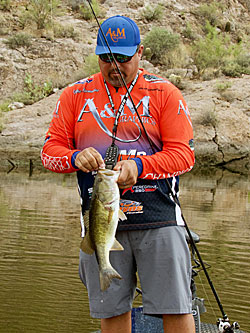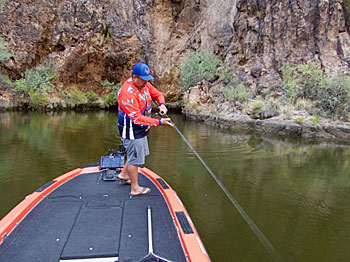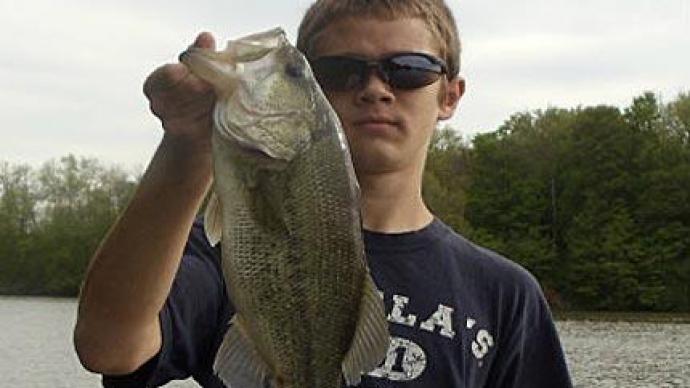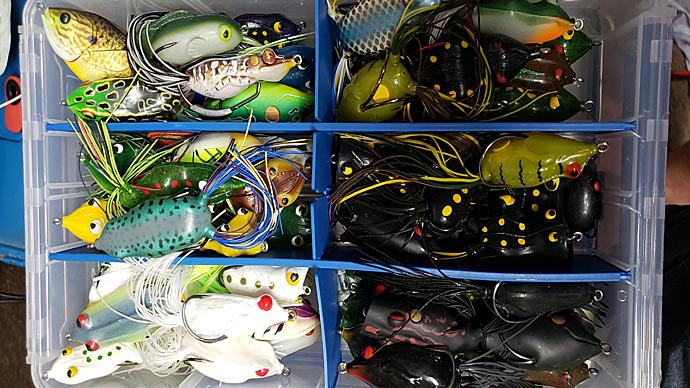
In deep clear reservoirs of central Arizona, you may not think of a frog as your first choice for a topwater bait. However, Max Hernandez has loaded the boat with nice fish on a Spro frog, even without fishing slop or weeds. A frog is a great topwater bait in any lake, weeds or no weeds. If you find some heavy cover, you don’t have to switch baits – you already know that frogs are designed to skim right over that stuff without getting hung up. Frogs are great, and there are a few things you can do that will make your frog fishing even more successful – pick the right lure, control your casts, use the right equipment, pay attention to current, and master the retrieve.
Choosing A Frog
Hernandez picks Spro Bronze Eye frogs because they have fantastic hooks and soft collapsible bodies that let those hooks do their job. But what he likes about these frogs is the way they’re made – they’re not flat on the bottom, they’re rounded, and that means he can skip it, walk the dog, bounce the nose down, or do anything else he feels like doing with it. The legs on these frogs (he was throwing Nasty Shad color, by the way) are strands of spinnerbait skirt material – they merely suggest legs, but that’s all it takes. You can replace the leg material if it gets chewed up or if you want a different color. Instructions are on the Spro website at www.spro.com.
As for color, the main thing is to choose something the fish can see. At Saguaro in the summer, the water can be green, and the Nasty Shad color shows up nicely. On cloudy days he favors darker colors. Sometimes what the fish do makes no sense – Max has caught dozens of big fish at night, with no moon, on white Spro frogs. Since they stay on top, it’s the silhouette that the fish need to see, more than the color. So choose a frog that will show up nicely against the sky and the tint of the water. One more thing – every few casts, Max grabs the frog and gives it a few squeezes to get any accumulated water out of it, so it floats well.
Control Your Casting

Max is one of the most precise casters I’ve ever seen, and that kind of precision takes practice. There’s no shortcut to this: you must get out there and make cast after cast after cast. The shorelines where Max fishes are riddled with rocky cracks and crevices, as well as small areas of tules. These small crevices may be only a foot or so wide, and they will be off at an angle. The goal is to cast that frog directly to the back of that little cut. Max catches the frog on the water, touching the shoreline most of the time. If you have to cast and recast, landing the bait in the middle or out in front of the cut, you may skip that one. The fish on these clear waters are pretty savvy, and if you start beating the surface and then trying again, you’re probably not going to get bit.
Fortunately, casting is something you can practice even if you’re not on the lake. Set up some targets in your backyard or even out on the street if that’s all you’ve got. If you’ve got a pool, that’s a bonus – float some rings on it and practice casting to them. Start with bigger targets in the yard or street and reduce the size as you improve. You’re going for muscle memory – pretty soon, your body will take over, and you’ll be casting precisely without effort. Some people recommend using cups as targets, but that teaches you to land the lure a few inches above the surface. Try flatter targets – paper plates, rings from ring toss games – stuff like that. Ideally, use the actual frog when you practice. The hooks are designed so they don’t hang up, so you should be able to cast it at rings with no problem. To protect the hook points, cut the erasers off a couple of pencils and stick them on the hook points. If you possibly can, get up off the ground, so it’s more like casting from the deck of a boat.
This practice will pay off when you’re on the water and want to put a frog in a four-inch gap in the tules. Once Max has the frog where he wants it, he reels it back pretty steadily, twitching the rod up and down a few inches. It’s almost like walking the dog; the Spro frog is perfect for this retrieve. You’ll need nerves of steel at times – you can see big bass following the frog, and it’s hard to control yourself, but you need to wait until you feel the fish set the hook.

The Right Stuff
Because a frog is designed to get big bass out of heavy cover, the hooks are beefy. Still, getting a hookset is easy because the frog's body is so soft and thin. But those big hooks take power to drive home, so you need equipment that can do the job. Max uses a Dobyns DC 766FLIP 7’6” medium heavy fast tip flipping stick. This rod has plenty of backbone for good hooksets, and the tip is soft enough to let you cast the frog with precision. Spro frogs have 4/0 Gamakatsu EWG hooks, so all you need to do is keep the points touched up. Braid is a must, so even if you hate braid, suck it up and spool some on. Max uses 50- to 65-pound-test braid and goes up to 80 if there are many tules. Because braid has no stretch, it’s ideal for transferring power from the rod to the hooks.
A rig like this doesn’t have to be heavy, and in fact, it’s worth it to pay for a high-quality rod. A good frog rod should have lots of backbone and power, but you want it to be light and balanced so you can throw all day and not get worn out by noon. Two or three hundred dollars sounds like a lot of money for a rod, but the Big Fish pot in your local tourney will probably cover that.
Moving Water
There are lots of lakes that have current moving through them. Nearly every lake has current, but you don’t notice it. The fish do, though. Saguaro Lake is one of the Salt River chain lakes in central Arizona and a pump-back lake. This means that this lake has a LOT of current twice a day. In the morning, water is sucked in the direction that would be upstream if the river weren’t dammed, and it can flat out a move at times. In the afternoon, the water is dumped back into the lake from Canyon Lake, which is upstream, generating power for the lakes' cities. The point is, this creates quite a bit of current, and fish pay attention to that.
If the current is strong, fish will find an eddy behind a rock or something and hang out. They’ll face into the current and wait for a snack to drift along. If you’re fishing against the current, you won’t be as successful as you would be if you used the current to your advantage, simply because the fish don’t see your bait coming. Max uses the current, fishing his frog in the same direction that the current is flowing, and working it skillfully around the rocks and over the eddies where big fish hang out. Tules don’t stop the current, so pay attention even when you’re practically flipping the frog to the reeds.
There are times when the current is so strong you can see it, and other times it is subtle. Like a hunter tossing a bit of fluff in the air to see which way the wind is blowing, watch the surface for floating leaves and bits of stuff to see if, any which way, the water is flowing. It will help you catch more fish.
Master The Retrieve
Max works the Spro frog effortlessly, and you must watch him figure out what he’s doing. He leaves a bit of slack in the line while working it, which lets the frog move side to side a bit. He doesn’t move the rod from side to side. He twitches it up and down – that little slack line that lets the frog’s head shake from side to side and gives it that enticing walk. If he’s working a tiny cut and wants to keep the frog in the strike zone longer, he feels a tiny bit more slowly, still keeping that slight side-to-side motion.
Keep the same motion if you’re working a frog over a bunch of slop or even a mat of floating debris. I know some people move it quickly from open pocket to open pocket, but the fish can sense and see that movement even when the frog is on top of a bunch of stuff. Keep the steady movement, so the fish knows where to strike. Most of the time, you’ll want to fish it reasonably slowly, but that doesn’t mean it’s a slow bait to fish. Cast precisely, walk it over the bass zone, reel it, and re-cast. You can cover a lot of water with a frog, and your odds of getting a big fish on this bait are excellent. Frogs should be a big part of your summer arsenal whether you’ve got slop on your waters. It will work where you fish if it works in the central Arizona reservoirs.
BassResource may receive a portion of revenues if you make a purchase using a link above.




